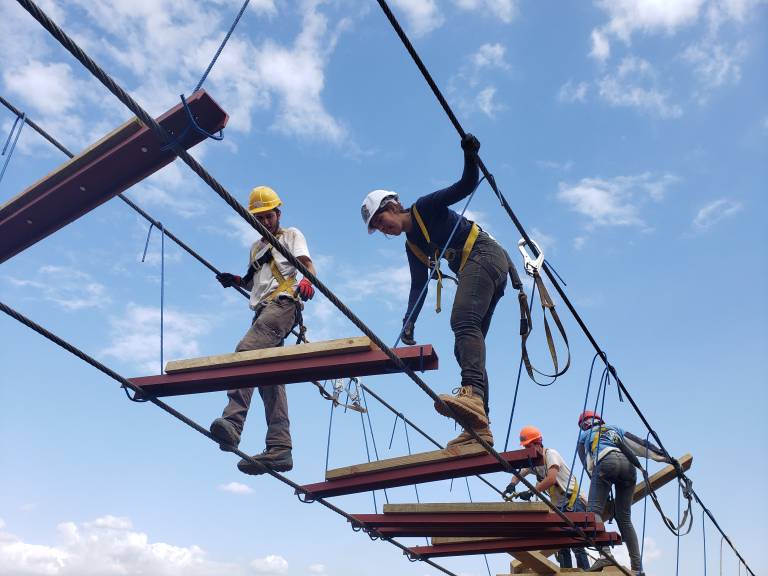CEGE students complete Eswatini bridge project
24 September 2019
Five students from UCL Civil, Environmental and Geomatic Engineering (CEGE) spent two months over summer 2019 constructing a suspended footbridge in Eswatini, as part of an Engineers in Action project. Team lead Signe Swarttouw tells us more about the experience.

The Engineers in Action (EIA) Bridge Programme provides isolated communities with safe access to healthcare, schools and economic opportunities through the construction of footbridges. They work together with university teams who are involved in the programme from the design of the bridge, to the completion of construction. UCL is the only university outside North America with a student chapter, and this trip to Eswatini marked the conclusion of a year-long project for us, with our contingent of the team consisting of Construction Managers Sally Warren and Mungo Cullinan, Logistics Manager Joe Lewis, and Bridge Engineer/Quality Control Manager Fernando Garrido Carreras - all CEGE students - alongside myself as Project Manager. We had all spent the months prior to our trip preparing designs, construction schedules and safety plans for the bridge. We also attended a pre-travel workshop run by the Engineering for International Development (EfID) Hub, and delivered by Engineers without Borders UK. UCL’s EfID kindly gave a financial contribution to the project, as well as support with pre-travel administration and logistics for our team.
The bridge built by us, together with our peers from Rutgers University in the US, crossed the White Mbuluzi River in the community of Bhekinkhosi. With a span of 51 metres, the bridge allows community members to cross the river, a feat otherwise impossible during the rainy season, which lasts in Eswatini for around five months of the year.
The student team was hosted at a homestead (small farm) on the top of a hill near the construction site, and each day everyone would walk down to start work at 8am. Once on site, we’d begin with a gathering of everyone working that day - students and community members alike - to discuss the work plan and what safety precautions should be taken. All safety concerns were thoroughly addressed, and the student safety manager ensured everyone used the proper personal protective equipment, such as hard hats and gloves.
Depending on the stage of construction, work days were filled with tasks like excavating foundations, mixing and pouring concrete, laying bricks and cutting cable. Students split up into groups, depending on how the group could be most efficient as a whole. Local masons and Bridge Corps members (experienced bridge builders) worked alongside the students and community members, providing guidance throughout all stages of construction. Days on site were long and filled with physical work, but the end of each day brought the team closer to the finished bridge. Students and community members alike became more and more excited as the bridge developed before their eyes.
On 23 August 2019, after six weeks of construction, the bridge was opened with an inaugural party, which the whole community, including local politicians and chiefs, attended to celebrate. It was fantastic to see such a large amount of people eager to cross the bridge once it was completed.
Overall, the trip was a fantastic experience for myself and the team. Not only did it allow us to put knowledge obtained in our Civil Engineering programmes into practice, it also taught us new skills which will help us throughout our careers, whether in civil engineering or otherwise. The bridge experience has provided a great insight into how civil engineering projects are actually realised, from their proposal and design, to their construction and completion. Furthermore, the project highlights the active role civil engineering can play in positively developing communities, not only by providing access to sustainable infrastructure, but also by actively engaging with the community throughout the construction process. During the project, the student team worked side by side with the local community members, forming friendships and bonds which will never be forgotten.
Signe Swarttouw, Engineering (Civil) BEng, 2016 – 2019
Links
Please note, some links may lead to external sites.
- UCL Civil, Environmental and Geomatic Engineering
- CEGE Undergraduate study
- Engineers in Action
- UCL Engineering for International Development Hub
- Engineers without Borders UK
Image
- Caption: UCL students from the Engineers in Action Team working on installing the decking planks on the Eswatini Bhekinkhosi bridge project.
- Credit: Eswatini Engineers in Action Team 2019.
 Close
Close

